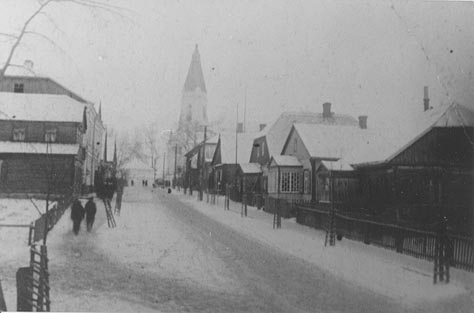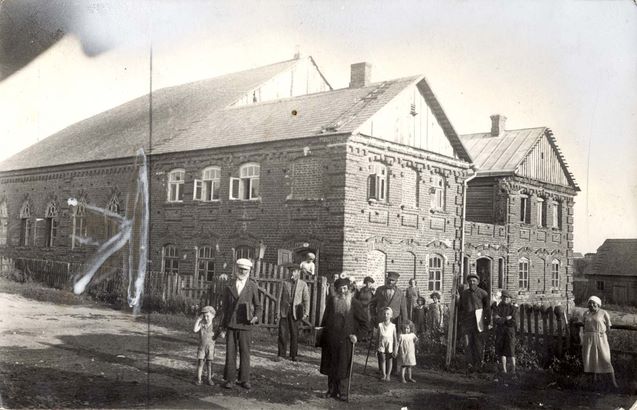

Shat (Sheta) is situated in the center of Lithuania. A dirt road of about 17 km connected it with the district town Keidan (Kedainiai).
Shat is first mentioned on historical documents during the 17th century. Early in the 18th century it was burnt down during the Swedish invasion. In 1785 the town was granted permission by the ruling king to hold two fairs per year.
Until 1795 Shat was part of the Polish-Lithuanian Kingdom, when the third division of Poland by the three superpowers of those times - Russia, Prussia and Austria - caused Lithuania to become partly Russian and partly Prussian. The part of Lithuania which included Shat fell under czarist Russian rule, firstly as part of the Vilna province (Gubernia) and from 1843 part of the Kovno province. In the 19th century Shat developed at a very fast pace, holding large trade fairs and weekly markets. During this period there were approximately 40 stores, bars, wine distilleries, a factory preparing pelts, flour mills and a drugstore. Towards the end of the Russian rule and the period of Lithuanian independence (1918-1940), Shat was the center of the county in Keidan district. During the autumn of 1915, heavy battles took place between the armies of Germany and Russia in the vicinity of Shat and a fire caused heavy damage in the town. For a short period in 1919, it fell under Bolshevik rule.
Once again in the Second World War the town was burnt down by the Germans. In the years 1941-1944 Shat was under Nazi rule with all its atrocities and murders.
Jewish Settlement until after the First World War
The Jews first settled in Shat at about the middle of the 17th century. It is recorded that the Karaites settled there in 1664 and in the eighteenth century there was a blood libel against a Karaite resident.
Shat was one of the few towns in Lithuania where the Karaites lived for many years.
For a number of years at the beginning of the eighteenth century, the Karaite rabbi Joseph ben Itzhak had lived in Shat, and the last time the Karaite community was mentioned in historical documents was in 1709. In the years 1679-80 there was a blood libel against the Jewish community.
During the period of the autonomous Jewish Council of Lithuania (Vaad Medinath Lita) (1623-1764) Shat was most of the time included in the Keidan Circuit.
Being far from a railway and from a highway it was difficult for Jews of Shat Jews to make a living. They were in trade and crafts and in transport as coachmen. In the nearby villages of Bukantz -Bukonys (10 km away) and Truskava (15 km away) Jews were engaged in farming. In 1847 there were 802 Jews living in Shat.

The town suffered frequently from devastating fires from time to time. In the years 1860 and 1878, 100 homes were burnt down, including the synagogue and Beit HaMidrash, and in 1892 again 115 homes were burnt down. The squire Montvila assisted those made homeless by the fires and in 1868-69 also assisted many in the years of drought and hunger. Every year he donated 25 rubles to the fund for Maoth Khitim which provided Matzot for the poor during Pesakh. In 1876 he also built anew the house of the Hakhnasath Orkhim ("Lodging for passers"). In 1889 the new bath was erected.
In 1897, 1640 people lived in town, of them 1135 Jews (69%).
Numerous lists of Jewish residents of Shat, census, revision, candle taxes, box taxes, rabbi electors, etc., including one containing over 1,000 names in the latter half of the nineteenth century are to found in "Lithuanian Archival Documents" (see below).
Jewish children were depended on their learning at the Kheder, until 1898 when a Jewish school was established by the initiative of the Rabbi Yisrael Levin. He rented a large and wide house and partitioned the rooms to provide a separate room for each class. He also hired good experienced teachers of various subjects, including Hebrew and its grammar, the Bible, etc.
The big Beit HaMidrash and the Synagogue were the center of the religious life of the Jews of Shat.

For the photo of the Beth-Midrash see "Seta Photo Gallery".
For a list of the Rabbis who served in Shat see Appendix 1.
In 1900 the institution Linath HaTsedek ("Righteous Lodging") was founded to assist the poor. The same year the Zionist Council was established by Elkhanan-Ya'akov Ritenberg and Betsalel Meitkis the first chairman being Zundel Rubensohn. Of those who donated to assist settlement in Eretz Yisrael from the years 1900 to 1903, quite a number of names from Shat are recorded. The fundraisers were A.Y.Wittenberg, Bezalel Hirsch Meitkis and in 1903 a Kurliandschik.
The HaMelitz database below lists 32 Shat donors in the years 1898-1900.
The reporters in HaMelitz from Shat were Sh. Rabinovitz and Ya'akov Glik.
At the old Jewish cemetery in Jerusalem a tombstone of a Shater Jew exists: Duber son of Avraham Segal, died in 1871.
The Bund (the Anti-Zionist Workers Organization) was organized towards the end of the 19th century followed in 1903 by the Young Bund. On the first yarzeit of the mourning for the pogrom at Kishenev, the members of the Young Bund climbed onto the bima of the synagogue and prevented the cantor from intoning the prayer for the health of the Tzar.
Copyright © 2000-2011 Joseph Rosin